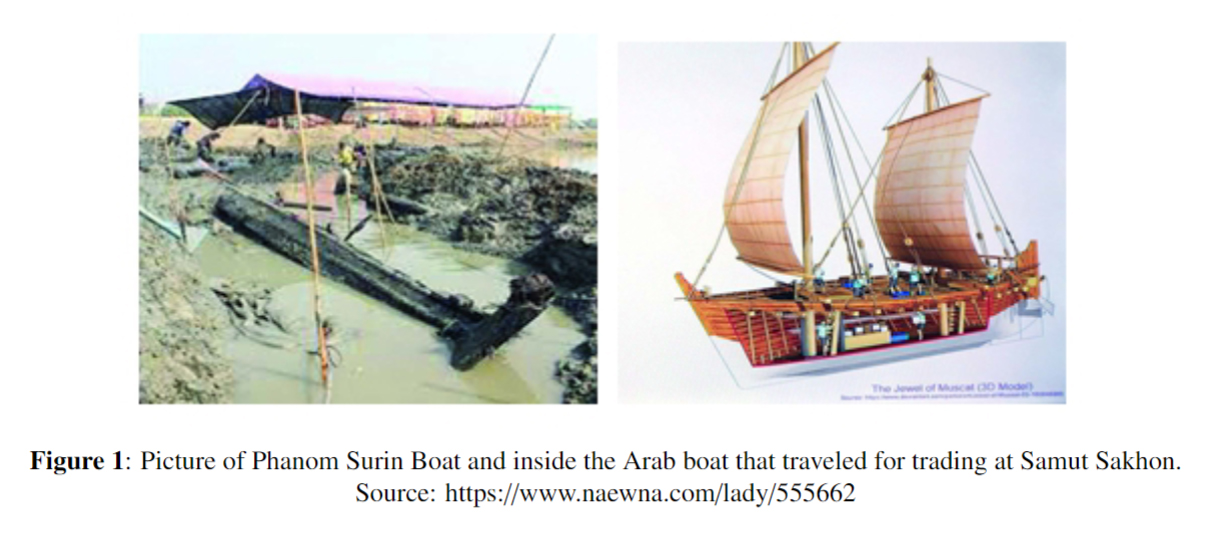Travelers, merchants, and foreigners appeared in facial stucco sculptures in Dvaravati humans in Nakhon Pathom Province
Main Article Content
Abstract
This research article is part of the research on innovation in the face of Dvaravati people, a case study of stucco sculptures and antiques in the Dvaravati period by Adobe Photoshop. Nakhon Pathom, originally called `Nakhon Phra Krit,' was an ancient city which has the largest city plan of all ancient cities in the Dvaravati era. It was also a significant port situated in the western of Chao Phraya River, between Mae Klong River and Tha Chin River. There was a great number of antique evidence discovered. This also showed the evolution of the growth of Nakhon Pathom, the city of significant geographical landmarks and locations, which developed to be a large city since the 12th-century B.E.. This ancient city was a port city that had marine transportation connecting local communities such as Kamphaeng Saen, Phong Tuk, and Khu Bua, as well as communities not far from coastlines. Furthermore, there were also river pathways shipping from the Gulf of Thailand, through Pak Nam to Nakhon Pathom Ancient City. There was a discovery of Phanom Surin shipwreck, around a shrimp pond in Phanthai Norasing Sub-district of Samut Sakhon Province which was around 8 kilometers from the coastline and not far from Nakhon Pathom. The shipwreck was an ancient Arab boat shipping goods such as ivories, betel fruits, coconuts, rice seeds, antlers, and Tang dynasty porcelains. It could be assumed a ship of merchants which was consistent with the discovery of antique evidence in Nakhon Pathom Province such as beads, ancient coins, seals, and Tang dynasty porcelains. This evidence could ascertain the contact of merchants between this city and the Middle East, India, and China. Furthermore, from the antique study of facial stucco sculptures of humans in the Dvaravati period, these sculptures were created to decorate religious sites. A great number of antique evidence found at Wat Phra Prathon Chedi, Chulprathon Pagoda, and Wat Phra Pathom Chedi showed that those facial stucco sculptures had various facial characteristics, i.e., facial appearances, turbans, usage of facial embroideries, which were different from local Dvaravati citizens. These sculptures evidence the traveling of travelers, merchants, and foreigners who focused on seeking fortunes, trading, and propagating religions.
Article Details

This work is licensed under a Creative Commons Attribution-NonCommercial-NoDerivatives 4.0 International License.
References
Fine Arts Department. (2006) The Study Project and Cultural Public Relation in Bang Kaeo-Bang Khaem Basin for Tourism Development. Nakhon Pathom : Petchkasem Publishing Co, Ltd.
Fine Arts Department. (2005) Antiquities in Phrathom Chedi National Museum. Bangkok: Office of National Museum, Fine Arts Department, Ministry of Culture
Thiva Supajanya and Pongsri Vanasin. (1982) “The Study of Characteristic of the Community from Aerial Photograh in Nakhon Pathom Province.” in The Seminar of Archaeological History and Culture in Nakhon Pathom. Nakhon Pathom : Silpakorn University and Chulalongkorn Alumni Silpakorn University.
Phasuk Intrawut. (1999) Dvaravati : a critical study based on archaeological evidence. Bangkok : Aksorn Samai
Piriya Krairiksh. (1981) “New Concept about Nakhon Pathom city before the 19th Buddhist Century.” in Arts Criticism Project. Bangkok : Silpakorn University.
Srisak Valipodom. (1985) “Dvaravati Federation”. Ancient City, 41, 4 (October-December), 25. Her Royal Highness Prince Krom Phraya Rissaranu Wat Tiwong. (193) Message of Somdej, Volume 3. Bangkok: Kurusapa Printing Ladphrao
Saritpong Khunsong. (2016) Archaeology Muaeng Nakhon Pathom A Study of the Past of the Center in Dvaravati. Bangkok: The Princess Maha Chakri Sirindhorn Anthropology Centre
Saritpong Khunsong. (2015) Dvaravati : Gateway to Trade on the Maritime Silk Road. Bangkok : Archaeology, Faculty of Archaeology, Silpakorn University
Beal, Samuel. (2001) “A ninth-century A.D. Arab or Indian shipwreck in Indonesia: first evidence for direct trade with China.” World Archaeology 32, 3 : 335 - 354. Francis, Peter
Beal, Samuel. (2002) Asia’s Maritime Bead Trade 300 B.C. to the Present. Honolulu : University of Hawai’i Press.Indrawooth, Phasook
Beal, Samuel. (1979) “East Asian Historical Sources for Dvaravati Studies.” in Proceeding Seventh IAHA Conference vol.II. Bangkok : Chulalongkorn University Press. p.1197-1150. Yasuda, Yoshinori.


